Pick of the Brown Bag
December 12, 2018
by
Ray Tate
Salutations. Allow me to introduce myself. I’m Ray Tate, the progenitor of the Pick of the Brown Bag. Each week I eye the best and worst comic books; to suggest should you need it and save you coin.
In this installment, I critique the Batman Annual, Detective Comics, Supergirl, Titans, The Unbeatable Squirrel Girl, The Unstoppable Wasp, X-23 and X-Men Red. I’ll also review Chandra a new book from IDW. First, we begin the tour with our old blithering Black Label buddy Batman: Damned. If you have no time for the blog, you can find fresh teensy reviews on Twitter: #PickoftheBrownBag.
Batman’s Dark Penis caused a public outcry and coincidentally increased publicity in a book that would have otherwise gone unnoticed.
Now, like a mirage, Batman’s penis disappears and in its place…
Crotch.
The second issue of Batman: Damned increases crotch shots by ten-fold, and if you ask me, that’s a lot more disturbing than a single, lonely penis whimpering on the horizon.
The last crotch shot occurs when Batman strangles Harley Quinn, which exemplifies the kind of ham-fisted hackery passed off as mature writing.
Batman: Damned is a graphic novel not a bad movie. You cannot explain away the panel under the excuse of poor editing. Brian Azzarello’s script called for the scene, and/or Lee Bermejo’s input led to the scene.
Both possibilities. Equally bad. There’s only one reason to highlight crotches during a strangulation scene. The message reads Batman derives carnal pleasure from strangling women.
Even if I dismiss eighty-one years of Batman’s history and just focus on Azzarello’s Black Label baby, the scenario doesn’t add up.
Batman has good reason to strangle Harley. She stabbed him in the neck with a syringe, exposing him to an unknown substance. She rubbed her crotch against his as she unzipped.
The password today is…crotch. Crotch.
Neither the first nor second issue of Damned presents a single clue or an iota of foreshadowing to suggest Batman’s psychosis. So this aberration comes out of nowhere. Pun not intended.
Ah, but perhaps Batman isn’t in his right mind. If not, then this scene is doubly cretinous. That means something victimized Batman. Azzarello/Bermejo thus lack the sexual derangement reasoning to explain the crotch closeup. Bottom line. The focus on crotch doesn’t need to be in any book, including Batman: Damned.
Batman fans should save their money for more worthwhile projects like...
Batman: Damned isn’t really just about crotch. It’s also about sullying the memory of Bruce’s parents Thomas and Martha Wayne. I’m sure Azzarello fosters some adult drama excuse to retch up the dead, even fictionalized corpses. Probably some pretentious twaddle to say that Bruce’s lily white image selectively ignores Thomas’ infidelity. Of course, Thomas Wayne’s strumpet sampling is something Azzarello conjured solely for his Curly of a project. I can’t even rate it a Larry.
Peter Tomasi’s Detective Comics like Damned addresses Martha and Thomas Wayne but in a far more ingenious way.
Batman investigates a double murder with victims made to look like Thomas and Martha Wayne. Tomasi displays Batman’s detective skills in a situation that could have played straight out of a Sherlock Holmes story. It’s that good.
Other differences present as Batman examines the corpses further.
As Batman continues his involvement, I found myself becoming rapt in the mystery. If the perpetrator went to all this trouble to replicate the Waynes through the victims, why did he or she leave them floating at the Gotham City Aquarium? Why didn’t he leave them splayed in Crime Alley the site of the Wayne murders?
The fact that I’m asking such questions indicates the level of engagement I felt with Detective Comics.
Tomasi is known for his whacked out stories in Batman and Robin. Seeing him boil his talent down to what amounts to a straight-up puzzle is a pleasure. Tomasi though must feed that beast, and so we cut to Batman staple character Leslie Tompkins running for her life.
I’m going to spoil this a little. Whatever’s chasing Leslie Tompkins is nothing like you’ve seen before and given extraordinary life and threat by Doug Mahnke, who has a forte for such creatures. Inker Jaime Mendoza and colorist David Baron breaking out his Hellboy reds back up Mahnke.
As the artists render this nightmarish hunt, Tomasi reminds the reader of Batman’s “matchless knowledge” of Gotham City. Batman knows Gotham like Sherlock knows London.
Tomasi furthermore is equal to Grant Morrison when fusing Batman’s historical nineteen fifties science fiction elements with his rooted detective work.
Do the posted examples and review whet your appetite? Believe it or not, better scenes can be found in Detective Comics. They simply divulge more than I’d like to reveal. Leslie Tompkins demonstrates her intellect, courage and loyalty. She’s not just a victim in this tale. When she realizes what’s really going on, she becomes a lioness. This is the stuff, and I am all-in.
The Batman Annual by Tom Taylor is a moving exploration of the relationship between Batman and Alfred. Alfred’s point of view takes up the majority of the narrative. He begins his tale by explaining how he got to where he is.
In fact, consistency frames Alfred’s history in the DC Universe more than most. He comes from a family of butlers. He inherited his position from his father. He dreamed of returning to acting in theater. His service to the Waynes extending to their son changed his plans.
Taylor’s annual next expands to the present day where Batman is in a life and death fight against a master of drones. This leads to explosive situations captured with the clean line work of Otto Schmidt set against a Deco Gotham. Schmidt wowed me on Nightwing. Little did I know his best was yet to come.
Taylor juxtaposes Batman’s investigation, engrossing in itself, with familiar comedy between Alfred and Batman. Batman in this issue is suffering from the flu. So, naturally, Alfred makes him some chicken soup.
As the story continues, Batman confronts the Drone-Maker, but things go horribly wrong. Alfred must rescue his charge.
I know what you’re thinking. Batman needs rescuing? How is that possible. Not to worry. Taylor makes this unpredictable moment plausible.
Batman’s rescue also requires another appearance by Leslie Thompkins, who finally convinces Bruce that he should get some rest, but not for the reason you expect. The ending exhibits humanity and warmth from a character that some believe has none. Just go out and buy this. You won’t be sorry.
Oh, Titans, you beautiful continuity devourer. Unlike many writers, Dan Abnett does not eschew continuity. He instead embraces the hell out of it.
Because of events in Aquaman and Justice League involving the crossover story “The Drowned Earth,” the Titans found themselves marooned on an inhospitable planet. This however is a planet in the DC Universe, and although rescue is unlikely, it’s certainly not impossible. I can reveal now, because you’d have to be the writer of Batman: Damned not to figure it out, the green-clad chap on the cover rescues the Titans.
On page one, Abnett’s thirst for continuity begins. More on the breakage of the Source Wall, what catalyzed Dick Grayson’s reformation of the Titans. Because of the Titans and failed attempts to read the Justice League I became aware of the fractures. Until now, I wasn’t aware that Kyle once had become a demigod.
Thanks to a spiffy entrance beautifully illustrated by Clayton Henry and Marcelo Maiolo Green Lantern brings the Titans home to earth and the Hall of Justice. The Titans immediately notice a change.
Right there. Abnett could have glossed over “The Drowned Earth,” but no. He recognizes the event. Ben Rubel, the Titans’ scientific advisor from Catco in Supergirl adds more detail, but Donna curtails any more discussion of the matter.
The Titans settle in and split up in the Hall. Donna and Green Lantern spar as an audience of one watches.
Donna’s flintiness is due to Batman and the Justice League dissolving the reformed group from Donna’s past; a past incidentally that does not really exist and is due to Wally West’s return. The memories are echoes of a dead universe readjusted to fit the history of the New 52.
Not content to wallow in current continuity, Abnett decides to remind readers of past New 52 continuity.
The Parliament of the Red. Scott Snyder’s Animal Man balance for Swamp Thing’s Parliament of the Trees and Abigail Arcane’s Parliament of Rot. Abnett’s use of Beast Boy as the Red’s avatar, brilliant.
Although the Blood Cult is on Donna’s radar, Miss Martian’s attempt to locate Raven’s soul-self leads the team into battle with Kyle Rayner joining them.
Titans should be a slog, but Abnett’s mastered the art of infusing continuity to his story where it counts the most. You shouldn’t care about any of the Titans since all of them are mouth-pieces for that aforementioned continuity jamboree, but Abnett makes each Titan real. The guest appearances should feel gratuitous, but does anybody not like Kyle Rayner? Abnett’s employ of the Green Lantern simply fits, and the whole story draws strength from Batman. He stamps his approval on Donna becoming leader. He now respects Donna. Titans is simply put intensely entertaining and flying so low under most readers’ radars.
Like the Batgirl Anniversary issue, Supergirl’s anniversary special is an anthology of short stories. In the first vignette by series writer Marc Andreyko and visiting fan favorite artist Emanuela Lupacchino, Kara visits the site of Krypton’s destruction.
You may argue that her choice is foolhardy, but her cousin did the same thing in an early Post-Crisis issue of Superman. Superman eighteen is an outstanding mood piece illustrated by Mike Mignola with guest stars Hawkman and Hawkgirl, before being jumbled by continuity alterations.
Andreyko and Lupacchino for Supergirl’s sojourn plant a monster amidst the debris. Kara must battle it out while she dismisses the phantoms of the past.
The fight’s strong, demonstrating Lupacchino’s artistic skill, but there’s just not a lot of meat to it. Andreyko sets up the duel primarily to introduce a new antagonist that was a familiar face in one of DC’s cosmic-themed series.
The second story by Andreyko and Brad Walker spotlights Supergirl’s Coluan companion Dr. Z’Ndr Kol. Well illustrated, pleasant enough, and it also gives you a better understanding of Z’Ndr’s interest in Kryptonians. Of course, you may wonder why we’re even bothering with this third tier character.
The best of the lot is by Jerry Ordway and Tom Derenick. It’s a Christmas tale set back in the day when Supergirl had been adopted by the Danvers.
Continuity is iffy on this one, and it’s more in tune with the Supergirl television series. Supergirl’s bad day begins with a messy end to a threat, follows through with a classic holiday mishap and ends on two warm notes. One of the members of the Justice League cameos.
I know beans about Magic: The Gathering, but a flip-through of Chandra revealed some colorful sweet art by Harvey Tolibao and Joana Lafuente. I’m a tough sell for fantasy, but Chandra looked different.
As I read Chandra I realized that I was actually reading a super-hero book set in a fantasy realm. Presumably something to do with Magic, but how would I know?
Chandra uses fire-based superpowers to fight for the defenseless. That makes her a superhero.
Chandra is also a Planewalker, a word that defines itself. Unlike the rest of the denizens in this Magical universe, she can cross the planes.
We meet another Planewalker when Chandra comes home to Kaladesh to visit her mom, which reveals another difference that I disassociate from fantasy.
Chandra’s mom is Consul Nalaar. I see fantasy as more primitive with warring kings and barbarians. I tie civilization in with science fiction.
However you define it, this spinoff of Magic: The Gathering is a winner because the creative team know their craft, and may know as much about Magic as I do.
The Unstoppable Wasp is Nadia Van Dyne nee Pym, the daughter of Hank and Maria Pym. Trained in the KGB’s Red Room to be an assassin, Nadia escaped and came to America to establish the invention lab GIRL.
Nadia saw a gap between male and female geniuses that demanded filling. In the previous volume, she found her geniuses. Janet Van Dyne, the original Wasp, became utterly charmed by Nadia and adopted her. She provides funding for GIRL and investment savvy.
Bobbi Morse, Nadia’s idol, and a scientist before becoming Mockingbird, assumed the rightful place as mentor. Nadia also convinced grapplers Letha and Poundcakes to reform. She furthermore freed her friend Ying, a genius in her own right, from the Red Room. Now, GIRL must battle AIM.
There’s the right way to project loss and a wrong way to project loss. This is the right way. How can a group of hapless beekeepers justifiably defeated and humiliated in a previous issue be successful against a group of girl geniuses that outmatch them?
First, they’ve got help.
Second, they help's got tactics.
Third, they know Nadia’s weakness and one of her strengths are the same thing.
This superb issue shows how even the smartest kids in the room can be believably overwhelmed without insulting their intellects.
The superhero community held a hilarious funeral for their beloved colleague Squirrel Girl. Thing is although it seemed like she sacrificed herself for the greater good, Doreen Greene still lived. A doppelgänger took her place, and she didn’t sacrifice her life either.
Squirrel Girl came clean with her circle of friends and Iron Man. She and her gang came up with codewords to identify themselves. Alas, Doreen forgot one thing. Databus. Tony’s Farnan.
A Skrull easily took Iron Man’s place, but she didn’t fool Doreen because of one tiny slip. Squirrel Girl now knows the truth. How though can you stop a Skrull that appears to have the power of Iron Man? Doreen calls up advice from her friends with unusual results that give the book its best laughs.
Once Doreen modifies the stratagems, she corners the Iron Man. Presented with an uninviting comeuppance the Skrull comes clean. When the Skrull resumes her shape, she’s not what Squirrel Girl and Nancy expect.
Ryan North anticipates the smart reader in a rare Squirrel Girl drama/comedy. Most of the story is straight up super-hero antic with the Skrull being particularly sincere. Also, Derek Charm's illustration certain lives up to his name.
After disrupting the Stepford Cuckoos plans, X-23 and her sister Honey Badger return to tracking down the scientists that stole Laura’s genetic material. Gabby is getting an ice cream.
Writer Mariko Tamaki continues Tom Taylor's All-New Wolverine as X-23. The differences are pretty nuanced. One of the themes Tamaki picks up, no doubt because it's a plot device useful is Taylor's penchant to turn Laura into a police consultant.
As Wolverine, Laura became a defacto Batman. In Tamaki's cable hands she becomes more like an Agent of SHIELD.
Laura quickly confronts the problem. At first the creature seems unfamiliar, but in hindsight, it becomes immediately recognizable. Its friends add to the complications.
A Big Bad influenced humans and mutants alike to create apparent random acts of violence that were in fact an orchestrated apocalypse.
The villain did this as Jean brought together the visions of poets, scientists and philosophers melded in her mind to the United Nations in order to establish Mutantkind as its own august body. Namor and Black Panther, kings of their respective countries, vouched for Jean. A Scanners like attack on a representative scotched those plans.
With the help of newly discovered mutants Trinary and Gentle, Jean and her team code-named X-Men Red countered the attacks. Public sentiment turned against Jean Grey and her mutants. Nations and local authorities hunted them until Jean finally exposed the truth about the Big Bad. Even so, some FOX-like pundits remained disdainful. The majority however realized they had been victimized by science fiction.
Now, humans and mutants alike depend on Jean Grey and X-Men Red—Namor, Gambit, Gentle, Trinary, Wolverine, Honey Badger, Night Crawler and Storm—to save them.
The villain holed up on Genosha and attempted desperate ill thought contingency plans before Jean, inspired by Honey Badger, conceived of the no-win scenario that protected all from the power.
The conclusion of X-Men Red consists of a team-up between Jean’s group of X-Men and classic Avengers. Jean, her X-Men and the Avengers storm the beaches of Genosha protected by mind-controlled victims. What’s to stop the Big Bad from controlling the teams? That would be telling.
The Big Bad engages endgame. The villain takes over a SHIELD Helicarrier and sets off its nuclear engine. The teams have a counter even for that in this engaging tactical battle. Furthermore, the group imagined their own checkmate for the villain of the piece. It’s breathtaking.
Smart, well-illustrated and filled with comedy as well as daring-do, X-Men Red is a triumph over convoluted X-Men continuity and humanistic in philosophy.























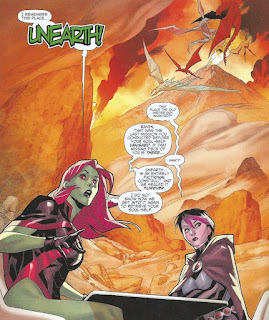

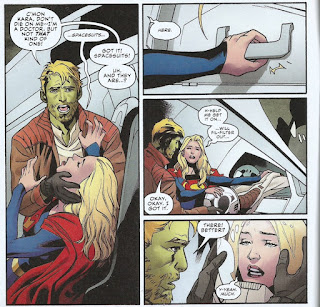

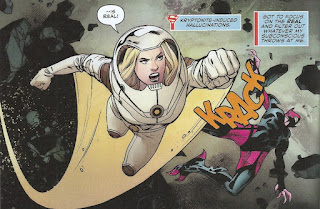












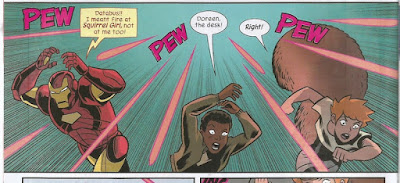



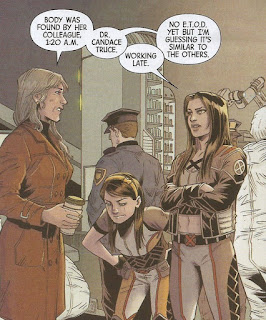


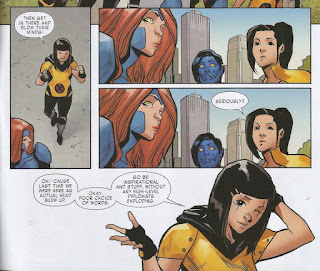


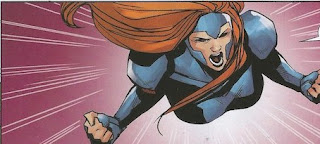
No comments:
Post a Comment